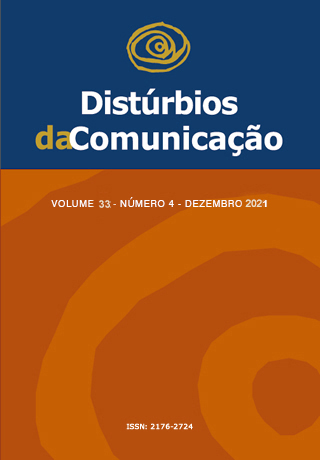The use of the flipped classroom as a teaching-learning strategy in emergency remote education in Speech, Language and Hearing Sciences
DOI:
https://doi.org/10.23925/2176-2724.2021v33i4p606-614Keywords:
Speech, Language and Hearing Sciences, Education, Higher, Education, Distance, Pandemics, Coronavirus InfectionsAbstract
Introduction: Emergency remote education has been adopted in Brazil due to the SARS-CoV-2 pandemic. Among the pedagogical possibilities, the flipped classroom stands out. Objective: To describe the experience report of the flipped classroom as a teaching-learning strategy in a course of the Speech, Language and Hearing Sciences. Method: Optional module of an undergraduate course in Speech, Language and Hearing Sciences was offered remotely for five weeks, adopting the flipped classroom. Digital platforms were used to provide content for asynchronous classes. The synchronous sessions, carried out on the Google Meet platform, were performed through simulated cases discussed orally and playful activities. At the end of the course, a Portfolio was delivered (as an evaluation of the module), and a student self-assessment was completed. There was a virtual discussion, among the teachers, of the results obtained. Results: A total of 19 participants. The teachers evaluated the satisfactory and pertinent method because of the pandemic. The previous reading of the material provided allowed the knowledge of the content. In the synchronous meetings, there was a reflection of the simulated cases and the elucidation of doubts. As negative points, the course’s duration, the difficulty of the group’s notion, and the exposition of ideas stood out. As positive, the playful strategies that motivated the adhesion in the module’s proposal. The average of evaluative activities and self-assessment were close, showing similar perceptions between teachers and students. Conclusion: The flipped classroom was an efficient strategy for remote academic activities due to its easy applicability and motivational factor.
Downloads
References
Hodges C, Trust T, Moore S, Bond A, Lockee B. Diferenças entre o aprendizado online e o ensino remoto de emergência. Rev esc prof educ tecnol. 2020; 2: 1-12.
Arruda EP. Educação Remota Emergencial: elementos para políticas públicas na educação brasileira em tempos de Covid-19. EmRede. 2020; 7(1): 257–75.
Nascimento FGM, Rosa JVA. Princípio da sala de aula invertida: uma ferramenta para o ensino de química em tempos de pandemia. BJD. 2020; 6(6): 38513–25.
Almeida DV, Santos VLP, Mercado LPL. Desafios da estratégia didática da sala de aula invertida no ensino superior. AEC&D 2020; 1(2): 21–31.
Bollela VR, Cesaretti MLR. Sala de aula invertida na educação para as profissões de saúde: conceitos sssenciais para a prática. Rev eletrônica farm. 2017; 14(1): 39–48.
Oliveira MA, Carreiro ELP. O novo normal da educação, quando o virtual não é fictício. Rev. Lagos. 2020; 11(1): 1–3.
Akçayir G, Akçayir M. The flipped classroom : a review of its advantages and challenges. Comput. educ. 2018; 126: 334–45.
Oliveira LR. Fonoaudiologia e Terapia da Fala: histórico das profissões no Brasil e em Portugal. Universidade de Brasília; 2018.
Sistema de Conselhos de Fonoaudiologia. Código de ética da Fonoaudiologia. Brasília: Conselho Federal de Fonoaudiologia; 2016.
Moffett J. Twelve tips for “flipping” the classroom. Med Teach. 2015; 37(4): 331–6.
Oliveira-Barreto AC, Guedes-Granzotti RB, Domenis DR, Pellicani AD, Silva K, Dornelas RC et al. Métodos de avaliação discente em um curso de graduação baseado em metodologias ativas. RIAEE. 2017; 12(2): 1005–19.
Conselho Federal de Fonoaudiologia. Resolução CFFa no 427, de 1o de março de 2013. Brasília: Conselho Federal de Fonoaudiologia; 2013.
Conselho Federal de Fonoaudiologia. Medidas de controle de infecção para fonoaudiólogos: manual de biossegurança. Brasília: Conselho Federal de Fonoaudiologia; 2006.
Oliveira J. Thiaguinho - Simples Desejo part. Gilberto Gil (DVD Ousadia e Alegria) [Vídeo Oficial] - YouTube. 2000.
Nogueira TJAM, Melo LVS, Barrera DF, Leite LL, Ferreira M. Programa aprendizagem para o 3o milênio (A3M): ações criativas/inovadoras na educação superior. In: Poisson, editor. Prática docente. Belo Horizonte: Poisson; 2020. p. 23–34.
Oliveira TE, Araujo IS, Veit EA. Sala de aula invertida (flipped classroom) : inovando as aulas de física. Fís. esc. 2016;14(2): 4–13.
Teixeira RLP, Teixeira CHSB, Silva PCD. Utilização da sala de aula invertida em cursos de graduação em engenharia. Brazilian J Dev. 2019; 5(10): 19061–72.
Silva DSV, Sousa FC. Direito à educação igualitária e(m) tempos de pandemia: desafios, possibilidades e perspectivas no Brasil. RJLB. 2020; (4): 961–79.
Downloads
Published
Issue
Section
License
Copyright (c) 2021 Carla Patrícia Hernandez Alves Ribeiro César, Ana Carla García, Louise Moreira Rocha, Raphaela Barroso Guedes-Granzotti, Kelly Silva

This work is licensed under a Creative Commons Attribution 4.0 International License.









